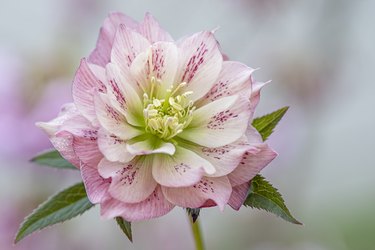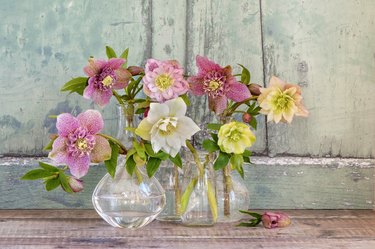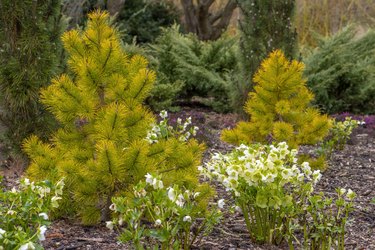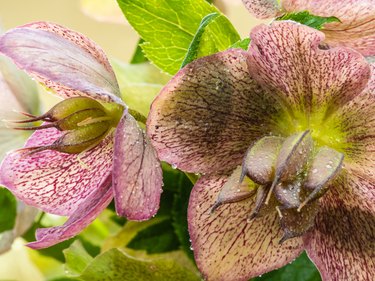
Experienced gardeners know and love the Lenten rose (Helleborus orientalis) and for good reason. The Lenten rose ticks a lot of boxes for gardeners. It's a hardy perennial that flourishes in U.S. Department of Agriculture plant hardiness zones 4 through 9, which makes it suitable for growers in most of the country. (Its only real downside is that all parts of the plant are mildly toxic, so be aware that it poses a threat to pets.)
The Lenten rose's hardiness means it's appropriate for most climates across the continental U.S., and it brings four-season interest to your shade garden with its dark green foliage and cold-weather blossoms. It'll even give you evergreen foliage in warmer areas, though it's deciduous in places with harsh winters.
Video of the Day
Video of the Day

The Lenten rose is absolutely beautiful. Depending on the cultivar you choose, you'll see single blossoms or clusters of up to four, in colors ranging from pure white to deep red and in single or double blooms. (The "petals" are actually sepals, or the outer part of the flower bud.) Mature plants stand 12 to 18 inches tall and can be clustered together or even planted thickly across shady hillsides and other problem areas to act as a ground cover.
So, how do you actually plant the Lenten rose? Without further adieu, here is our guide to planting Lenten roses!
Warning
Despite their roselike appearance and name, Lenten roses aren’t related to roses at all. They’re Ranunculaceae, part of the same family as buttercups, and like buttercups, all parts of the plant are mildly toxic to humans and pets. (The genus name, Helleborus, could be loosely translated from the Greek as “don’t eat that, it’s poisonous!”.)
It’s not usually a significant issue because the plants taste unpleasant enough to act as a deterrent, but there’s at least a modest risk to dogs, cats and horses. The ASPCA cites drooling, colic, abdominal pain, depression and diarrhea as common symptoms of hellebore consumption, so call your vet if you should see these symptoms.
Part 1: Planting Lenten Roses

Like most perennials, the Lenten rose does best in organically rich, well-draining soil, and it favors a slightly alkaline soil pH of 5.5 to 7.0. (If you don't know your soil's pH, test kits are inexpensive and easy to find.) It favors partially shaded or bright, full-shade sites where it's sheltered from late summer heat and the harshest and coldest of winter winds. Ideally, you should plant in early fall about two weeks before the average date of the first frost in your area, but planting after the last frost date in spring is also an option.
Once you've selected a suitable spot for your Lenten rose, you'll need to prepare the site and put in your transplants. It's a straightforward process:
- Spread a 4-inch layer of well-aged manure or rich, moist compost over the planting site a week in advance so the soil has time to settle. Mix the organic matter into the soil to a depth of 12 inches using a garden fork.
- Water the ground thoroughly after three days if there's been no rain to speak of to moisten the soil to a depth of 12 inches.
- Dig a hole as deep as the root ball of the Lenten rose plant and 1 1/2 times as wide.
- Put the plant in the hole and hold it with one hand so that the plant's crown is level with the surrounding ground. At the same time, scoop the dug soil into the hole with the other hand until the hole is full and the plant stands upright.
- Gently press the soil around the plant's base with flat hands to firm the root ball in the ground.
Tip
Planting the Lenten rose at the right depth helps prevent a common problem known as crown rot. The crown of the plant is the area where the stems join the roots. For hellebores (and many other garden plants), it needs to stay at the same height relative to the surrounding soil throughout its life cycle. Planting a Lenten rose so that the crown is covered with soil or covering the crown with mulches brings moisture into contact with the crown and causes the plant’s stems to rot.
Part 2: Caring for Lenten Roses

Hellebores and hellebore hybrids (we'll come to those) don't need a lot of special care once you've chosen a suitably sheltered and shady spot for them. One thing they do require is consistent watering because constantly moist soil is key to the Lenten rose growing well.
Water a newly planted Lenten rose with a garden hose fitted with a soft spray attachment, directing the water onto the soil at the plant's base and not the plant stems. When the water begins to puddle, stop watering. (They don't like soggy soil.) To help the Lenten rose establish quickly, water the plant when the soil surface is dry. Spreading a layer of garden compost 2 inches thick over the soil helps to conserve soil moisture and provide nutrients but don't allow the compost or other mulches to touch the plants' stems.
Lenten roses can be propagated in a couple of ways. They'll self-seed in late spring as the seed pods mature. You can carefully dig up those new seedlings the following spring (after they've had time to get established) and put them in the desired location. You can also divide an existing clump of hellebores in late spring after they've blossomed and relocate a portion of the cluster. Follow the same steps as you would when planting initially, taking care to keep the plant's crown at the same level and to damage the root system as little as possible. You can also simply gather mature seed pods and sprinkle them in an area where you want more of the flowers and wait to see how many sprout.
Part 3: Growing Lenten Rose Hybrids
A number of growers have hybridized Lenten roses with other hellebores to create varieties with different colors or growth habits. Lenten rose hybrids grow best in conditions similar to that of the Lenten rose.
Lenten rose Millet Hybrids (Helleborus orientalis 'Millet Hybrids,' USDA zones 4 through 9) prefers alkaline soil and moderate or light shade. Growing 12 to 18 inches tall and 18 to 24 inches wide, Millet Hybrids features rose, light pink or white flowers. Lenten rose Early Purple Group (Helleborus orientalis subsp. abchasicus Early Purple Group, USDA zones 5 through 9) is a hybrid that grows best in the same conditions as its Lenten rose parent. This hybrid grows 9 to 15 inches tall and bears plum-purple flowers with yellow stamens.
